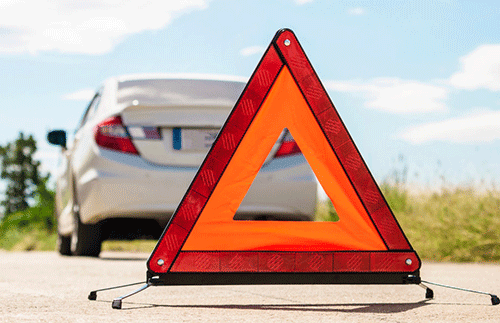Community policing officer
Generally, road safety is a fundamental concern for every road user and it is a shared responsibility to ensure safe and efficient traffic flow. One vital aspect of road safety often overlooked is the presence of an emergency warning sign, also referred to as warning triangles, in vehicles.
Most often when a driver experiences a breakdown or gets involved in a crash on our city roads, they seem to not know what to do next. Those with a breakdown may sit inside their vehicle while waiting for roadside assistance, while those involved in a crash if unharmed, they step out of the vehicle whilst awaiting police arrival.
Given that background, the Windhoek City Police sees the need for road users to know about the importance of warning triangles and the dangers associated with not having them in your vehicle.
What then is a warning triangle?
In simple terms, a warning triangle is a small red triangle, usually made of plastic and metal that has a highly reflective surface. Most vehicles are equipped with a warning triangle from manufactures, mainly placed in the boot or behind the rear seat. It is therefore important for vehicle owners to acquaint themselves so that they are able to locate warning triangles as the need arises.
As a driver or owner of a vehicle, one needs to be cognizant of the fact that, warning triangles serve as highly visible and recognisable indicators of a road hazard. Placing a warning triangle around your vehicle in the event of a breakdown or accident allows other drivers to spot the potential danger well in advance. This enhanced visibility is crucial in preventing secondary crashes, as it provides adequate time for oncoming traffic to slow down and take necessary precautions.
According to the Road Traffic and Transport Regulations of 2001 sub-regulation 233; In an event of a crash or breakdown a driver is expected to place an emergency warning sign at least 45m from the motor vehicle along or onto the roadway in the direction from which traffic will approach. Meanwhile, the same regulation stipulates that failing to display or to carry at least one doubled sided emergency warning sign in a motor vehicle, can lead to a fine amounting to N$750. Avoiding these legal repercussions is as simple as having a warning triangle readily available in your vehicle.
By using warning triangles, when necessary, drivers contribute to the overall well-being of all road users, as it is not only a legal obligation but also a moral act to ensure our actions do not endanger the lives of others on the road.
The Windhoek City Police therefore urges the public to embrace the responsibility of being safe and responsible road users by adhering to the law, keeping our vehicles equipped with warning triangles, and always putting safety first. By doing so, we not only protect ourselves but also contribute to the safety of all those who share the road with us.
Help the Windhoek City Police in its commitment to making Windhoek the safest city in Africa.
For any emergencies, contact the Windhoek City Police on 061 302 302/ 061 290 2239 or via SMS at 4444.

